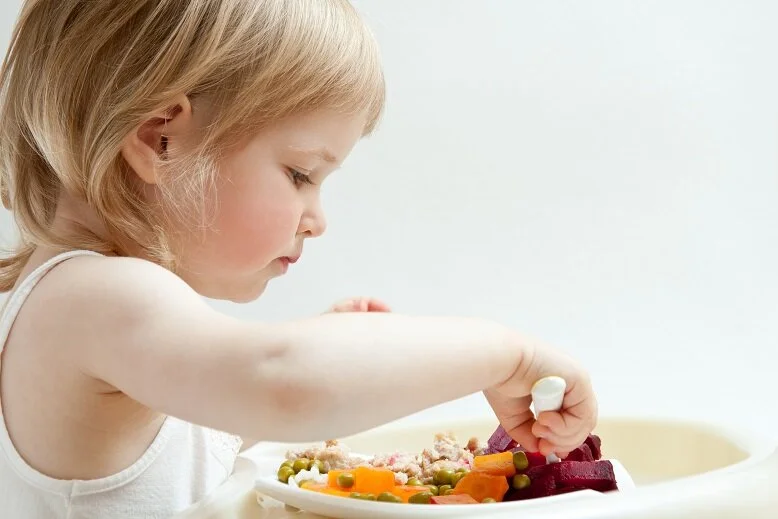We all want our children to eat well and be healthy. But even if we know exactly what our little ones should be eating, helping them develop healthy eating habits is often not as easy as it sounds. Picky eating, a lack of appetite, food sensitivities, insatiable cravings for pasta and cookies. There are other challenges too, and sometimes raising healthy eaters just seems like an impossible task.
But, there are ways to overcome all of these struggles - here are 5 simple tips to help you get started:
(1) SHOW WHERE FOOD COMES FROM
One of the most important steps in helping children build healthy eating habits is
Developing their understanding of where food comes from.
You can do that by visiting local working farms where children have the chance to learn about the process of growing and harvesting food. Some of these farms also sell the food that they grow, which is a wonderful opportunity for the children to try locally grown foods as well.
You can also grow food on your own – even if you don’t have a big garden or no garden at all! Get a couple of plant pots and some soil, buy seeds for fruits, vegetables or herbs that can be grown in a pot like cherry tomatoes, strawberries, radishes or basil and voila, you have your own portable vegetable patch that you can use to teach your little one about growing healthy food.
If your children are book worms, there are several fabulous books that support the development of healthy eating habits. Some of our favourites for toddlers and pre-schoolers include How Did That Get in My Lunchbox? by Chris Butterworth, The Boy Who Loved Broccoli by Sarah A. Creighton, Good Enough to Eat by Lizzy Rockwell, I Will Never Not Ever Eat a Tomato by Lauren Child and Before We Eat: From Farm to Table by Pat Brisson.
(2) INVOLVE CHILDREN IN FOOD PREPARATION
Research shows that developing cooking and food preparation skills early in youth has a positive impact on our children’s relationship with food and their nutritional well-being later in life.
Regardless of your children’s age, it is important to involve them in both food shopping as well as cooking and food preparation whenever you can.
Toddlers can, for example, help you find specific fruits and vegetables in the supermarket or help you wash the vegetables before you cook them, pre-schoolers that are skilled enough with a small non-slip kitchen knife can help you cut the vegetables or choose the spices for the meal you are making, and teenagers might even be able to cook an entire meal with a little bit of your support.
As you are cooking together, you can also talk about the specific foods that you are preparing – where they come from, how they are grown, what they taste like, how they can be prepared and how they affect their body.
The key is to treat this activity as a quality time together rather than a chore and make sure it is enjoyable for everyone involved.
(3) GIVE CHILDREN (SOME) CONTROL
Involving children in choosing what will be included in their meals is important to increase their sense of participation and control over their food choices, which ultimately also raises the likelihood of them eating the chosen food.
This of course doesn’t mean letting them pick the entire family meal every day, otherwise most of us would be eating pasta and ice-cream all the time!
Instead, present them with healthy options that they can choose from.
For example:
During grocery shopping, ask children to choose one new vegetable that they haven’t had before and that you can then cook together for one of your meals at home. You can do the same with grains, fruit, fish, meat or nuts and pulses.
If your children are a bit older, choose the main ingredient of the meal together (e.g. fish, meat, grains), and let them pick one or two specific recipes that you can then use to prepare the meal – ideally together. This will also help involve children in cooking which is essential for developing healthy eating habits.
(4) LEAD BY EXAMPLE
Children learn by observation and the same is true for eating habits. If they don’t have good role models that show them what healthy eating looks like, it is unrealistic to expect that they will grow up to be healthy eaters themselves.
So, what does leading by example look like when it comes to healthy eating habits?
One of the key steps is to eat together with the children whenever you can, rather than letting them eat alone.
Eat the same food as you are serving them - unless, of course, you have food allergies or food intolerance they don’t have.
If you don’t eat Brussels sprouts, it is not fair to expect your children to eat them, right?
When you do eat together, show them that you enjoy eating healthy food, which you can do by, for example, explicitly commenting on how good something tastes.
And finally,
Always eat at the dining table and avoid distractions during your meals, such as watching TV or using your phone.
When our children are distracted during their meals, they not only tend to eat more, but may also chew more poorly (which can reduce the absorption of nutrients from the food), and don’t fully experience the flavours of the food that they are eating.
(5) BE PATIENT & AVOID PUSHINESS
As parents we would all love if our children would eat and enjoy all the food the first time we serve it. But, the research shows that
It can take children up to 15 times to accept new food.
So, if your children don’t touch that salmon or cauliflower the first time you make it, do not despair.
Allow them to leave it on their plate if they don’t want to try it, and serve it again in a few days’ time, followed by another try a few days later, and so on.
During this process it is OK to ask the child if they want to touch, smell or eat this food, but it is very important not to push them, as this will can have the opposite effect. Instead, relax, allow them to take their time getting familiar with the new food and lead by example by sharing a meal with them and eating the same food they are eating.



